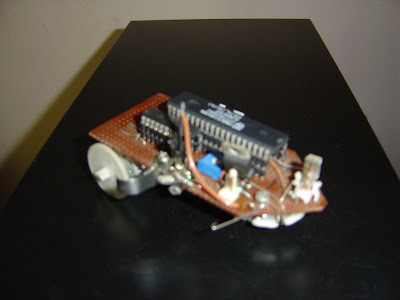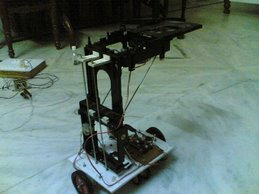AES Development Kit
Microcontroller 8051
(P89C/V51RD2 & AT89S52)
Contents:
1. AES 8051-DK (Complete PCB mounted with basic circuitry)
2. 16x2 LCD module.
3. A.C Adaptor (6 volts)
4. Serial Cable.
5. Programmer cable for AT89S52
6. Connectors for ports. (4 for 4 ports and 1 for ULN)
Overview of the Kit
Advanced Embedded Solutions : Development Kit for 8051 Microcontroller. Image 1
Interfaces provided on board for R&D purpose.
1. ULN2803 on port 0: 8 LED’s are connected to the output of the driver. LED’s should be enabled by placed a jumper on the 2 pin connector placed besides LED’s. A connector is also provided at the output of ULN. Other loads (ex. Stepper motor) can be connected at this connector. If driving load other then LED’s, remove the jumper.
2. Input Switches: 8 push-button switches are provided at port 1. These switches can be used as basic input device.
3. 16x2 LCD module: The LCD module is connected on board. Data bus of LCD is connected to port 2 (D0-D7). To enable LCD place a jumper on the two pin connector located below the LCD module. Control signals of LCD are derived from port 3 as mentioned in the above list.
4. Serial Communication: A MAX-232 transceiver is provided on board with capacitors (voltage doubling circuit), which provides serial communication between the Development board and serial
5. Besides the basic peripherals mentioned above each port is connected to a 10 pin connector (8 port pins & Power i.e. Vcc, Gnd), for the user to interface some other device if required.

Advanced Embedded Solutions : Development Kit for 8051 Microcontroller. Image 2
Powering up the AES 8051-DK
· The adaptor provided with the kit is a 6volt (A.C, 750mA) adaptor which can be directly plugged into the round shaped connector on board labeled as AC. Rectifier circuit is on board.
· The user can also provide a D.C supply of 12 volts to adjacent connector labeled as 12VDC.
· In both the cases the voltage to microcontroller circuit is provided through 7805 regulator IC.
· A push-button lock switch (labeled as AC/DC) provided selection between A.C & D.C supply (if one connects both).
· Pushing the switch to down position selects A.C supply. Releasing the switch selects D.C supply.
Installing the AES 8051-DK
1. Connect the A.C adaptor output to the connector on PCB.
2. Connect the serial cable provided with the kit on DB-9 connector (labeled as RS-232) between the Kit and the serial
3. Place jumpers on the pins (TXD, RXD).
4. Power up the system by pressing the push-button switch.(AC/DC)
5. The kit is ready for programming.
A tutorial on Philips flash magic:
Programming the microcontroller P89C/V51RD2BN using Philips Flash Magic
1. Open the Philips flash magic software.
2. Make the following setting in the software:
· Select the appropriate COM port where the kit is connected.
· Select the Baud rate (Generally keep it at 9600)
· Select the device (89C51RD2xx or 89V51RD2) according to the microcontroller place on board.
· Place a tick on “Erase all flash”
3. Brows your code’s .HEX File I the hex file space.
4. Click on the “Start” button.
5. The software gives a message “Reset the device in ISP mode now” (in case of 89V51RD2)
6. Turn the kit off by pressing the pushbutton switch (AC/DC) switch and then switch it on. The above box disappears and the hex file gets transferred.
ALTERNATIVELY
6. At this point press the “BOOT” switch on the kit. Reset the device by pressing the “RESET” switch (while keeping the BOOT switch pressed), and then release the BOOT switch. The above window disappears and the .HEX file is transferred to the microcontroller.
7. After the software shows “Finish” (bottom right of the window) Press “RESET” switch to execute your program.
8. In case of 89C51RD2xx, select this device, locate the hex file, follow STEP 6 (above) and then press start button on the software.
A tutorial on RIDE:
Executing sample programs using RIDE.
2. To make a new project:
· Specify a “Name”.
· Directory where the project is to be stored.
· Target family as 80C51.
· Click “Next”.
· Select the target device as: Atmel-AT89S52, or Philips-P89C/V51RD2xx.
· Clock on “Finish”
3. The place on the left hand side is the project window. It shows all the details about the project.
4. To create new file: File New C File.
5. Write your code into the window on the right and save it.
6. Right click on your project name in the project window and click on “Add node source/application”.
7. Brows the saved C-File and click ok. This includes the C-File in the project.
8. To generate .HEX file of the project press F9. The hex file is generated is there are no errors in the code.
9. The location of the .HEX file is shown at the bottom of the RIDE window.
10. This file can be directly transferred to the microcontroller using Flash magic.







.jpg)
.jpg)
.jpg)
.jpg)





.jpg)




